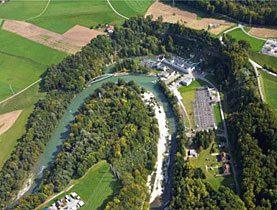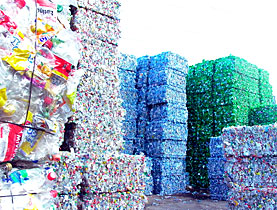Paying the price for past pollution policy

Thousands of tons of waste dumped in a landfill site near Fribourg between 1952 and 1973 is now threatening river life in the area.
Experts say the case is typical of past environmental practices in Switzerland, when no protection laws existed. Many more sites are said to be affected.
Waste disposal sites like La Pila, in French-speaking Switzerland, were the norm mid last century, when the country was undergoing a period of economic growth.
“Nobody realised that the environment had a limited capacity to absorb harmful substances,” said Marc Chardonnens, head of the canton Fribourg environment office.
Waste was simply dumped anywhere with no anti-pollution measures taken, he added.
At La Pila around 240,000 cubic metres of industrial and domestic waste products was tipped into the site. In 1973, when the dump was closed, it was simply covered over with soil – as was usual at the time.
“We don’t know for certain what exactly is underground. It was not obligatory to keep a register of waste in landfills,” Chardonnens told swissinfo.
Toxic cocktail
So far tests have found a cocktail of toxic and high polluting substances, including dioxins, furans and polychlorinated biphenyls (PCBs), in the River Saane.
The two-hectare landfill site is set right in the middle of the bend in the river, where the Saane makes a 180 degree-turn, making it easy for chemicals to leach out into the water.
“Until the 1950s it was usual for waste to go straight into the water. It wasn’t by chance that the first water protection law of 1955 was limited to banning the creation of landfills in watercourses,” explained Chardonnens.
A 1972 revision only went a little further, stipulating that sites should not harm water quality. But even then experts pointed out that it was impossible to stop substances seeping into water over time.
It was only in the mid-1980s that people started to question waste disposal methods. In 1996 landfill sites containing toxic chemicals were banned altogether.
Concerns raised
“It took a long time for people to start to seriously worry about damage to water quality from waste, phosphates… or mercury from industrial waste,” said Chardonnens.
The Fribourg authorities have now banned fishing in most parts of the river – to the anger of the local fishermen’s association.
“We can understand this reaction,” said Chardonnens. “But the law obliges us to protect public health. Dioxins, furans and PCBs, even in the smallest of quantities, can cause serious health damage.”
Alerted to the issue by the Fribourg authorities, the Swiss government in January announced that it had established a working group to look into water pollution on a national level.
Switzerland now has one of the most modern water protection laws, but there is no obligation for watercourses to be analysed for pollutants.
What lies beneath?
“Canton Fribourg is not even one of the most industrialised regions in Switzerland. We have to reckon with other cantons being faced with this ticking time bomb in the future,” Chardonnens said.
There is also no complete inventory of polluted sites in the country, although it is estimated that there are around 50,000 in existence. Cantonal registers will not be ready before 2011.
Finding out what lies beneath landfill sites and cleaning them up will be problematic and time consuming. Work on La Pila alone is expected to take around ten years and cost tens of millions of Swiss francs.
“Cleaning up all the contaminated sites in Switzerland from the last century will still need several decades and funds of at least SFr5 billion ($4.5 billion),” predicts Bernhard Hammer of the Federal Environment Office.
swissinfo, based on an Italian article by Armando Mombelli
There are around 50,000 polluted sites nationwide. These include up to 4,000 contaminated sites, which in the short or long term pose a hazard to human health and the environment through the release of harmful substances.
As this risk is not acceptable over the long term, the government has called for the”undesirable legacy” of past practices to be neutralised by 2025.
The legal basis for cleaning up these sites was only created in 1998, with a special law on the issue. Until now only around 200-300 sites have been cleaned up. The whole process is expected to take up to 30 years and cost around SFr5 billion.

In compliance with the JTI standards
More: SWI swissinfo.ch certified by the Journalism Trust Initiative


You can find an overview of ongoing debates with our journalists here. Please join us!
If you want to start a conversation about a topic raised in this article or want to report factual errors, email us at english@swissinfo.ch.